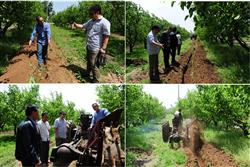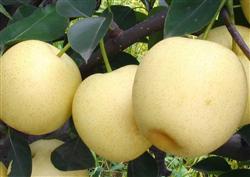Pear planting: how to fertilize pear trees?

How to plant pear trees and fertilize them? Please introduce fertilization methods for planting pear trees can refer to the following methods: first, applying more organic fertilizer to improve soil organic fertilizer not only contains various nutrients needed for the growth of pear trees, but also can improve the structure of the soil. increase soil nutrient buffer capacity, increase soil water retention capacity, improve soil ventilation, and reduce soil root growth resistance. It is beneficial to the growth and development of pear trees. Second, the application of nitrogen fertilizer nitrogen is one of the more required nutrient elements for pear trees. Nitrogen fertilizer absorbs about 0.4-0.6 kg of nitrogen for every 100 kg of fruit. The use of nitrogen fertilizer has a great effect on the growth and development of pear trees. Proper application of more nitrogen fertilizer in a certain range can increase the number of branches and leaves, enhance tree potential and increase yield. However, if excessive nitrogen fertilizer is applied, it will cause shoot growth, which will not only cause nutritional imbalance of fruit setting, but also induce the occurrence of physiological diseases such as calcium deficiency. Among the three elements of nitrogen, phosphorus and potassium, young pear trees relatively need more nitrogen, followed by potassium, and absorb less phosphorus, which is about 1 / 5 of nitrogen. After the results, the proportion of nitrogen and potassium absorbed by pear trees was basically similar to that of young trees, but the amount of phosphorus uptake increased, which was about 1 / 3 of nitrogen. There should be some differences in fertilization. In general, when pear trees are young, according to the size of the tree, the amount of nitrogen fertilizer applied per mu of pure nitrogen is 5: 10 kg per year, which is gradually increased to 15: 20 kg after entering the fruiting period, and the individual varieties that need more fertilizer can be increased to 25 kg. The nitrogen uptake of pear trees was the most in the shoot growth stage and the young fruit expansion stage, followed by the second fruit expansion period, and the fruit absorption was relatively less after picking. Therefore, the application of nitrogen fertilizer mainly has three stages, the first stage is topdressing a certain amount of nitrogen fertilizer before flowering after sprouting, which can increase the fruit setting rate, promote the growth of branches and leaves, help to increase the ratio of leaves to leaves, and maintain the balance of vegetative growth and reproductive growth. especially for young trees and fruit trees with weak potential, topdressing nitrogen fertilizer can promote branch and leaf growth and enhance tree potential; the general application rate is about 1 / 5 of the annual nitrogen application rate. However, for the more prosperous fruit trees, it is generally not suitable to apply nitrogen fertilizer in this period, in order to prevent the vegetative growth of pear trees from overgrowing and affecting the hanging fruit. The second fertilizer application period is after the peak growth period of new shoots, and before the second expansion period of fruit, proper topdressing of nitrogen fertilizer combined with phosphorus and potassium fertilizer can help to improve yield and quality, but not too early to prevent the vegetative growth of branches and leaves from overgrowing. affect the sugar content and quality of pear fruit; the amount of fertilizer applied in this period is about 1 × 5 of the amount of nitrogen fertilizer applied in the whole year. The third fertilizer application period is that topdressing in time before pear fruit harvest can prepare for sprouting, blooming and fruiting in the following spring. For the pear trees with weak tree potential and more fruit, if the base fertilizer can not be applied in time after harvest, a certain amount of nitrogen fertilizer and phosphorus and potassium fertilizer can be applied properly to restore the tree potential and alleviate the nutrient deficit of the tree, so as to prepare for the growth and development of pear trees in the coming year. 3. Proper application of phosphorus and potassium fertilizer is also a large nutrient element for pear trees. For every 100 kg of fruit, it is necessary to absorb 0.1-0.25 kg of phosphorus pentoxide and 0.4-0.6 kg of potassium oxide. The experiment on the fruiting pear trees showed that the combined application of phosphorus and potassium fertilizer increased by 50% to 85% compared with the application of nitrogen fertilizer alone. The application of phosphorus and potassium fertilizer can not only increase the yield of pear trees but also promote the growth and development of roots and increase the coordinated transport of photosynthates in leaves to stems roots and fruits. At the same time phosphate fertilizer has a very significant root induction effect. Moderate and deep application of phosphate fertilizer can promote the root system to extend to the deep soil significantly improve the drought resistance of fruit trees and reduce the occurrence of diseases. When the content of available phosphorus and potassium in soil is high, the application of phosphorus and potassium fertilizer often has no fertilizer effect, and better results can be achieved only by paying attention to the combined application of nitrogen fertilizer and phosphorus and potassium fertilizer. Reasonable application of boron zinc iron and other trace element fertilizers can significantly reduce the incidence of fruit shrinkage disease increase fruit setting rate and reduce the formation of corked areas in pear pulp. For pear trees with potential boron deficiency and mild boron deficiency, borax aqueous solution with a concentration of 0.3% to 0.4% can be sprayed at full flowering stage. The soil with serious boron deficiency can apply 100% 250 grams of borax to each fruit tree before germination, and the period of validity can be up to 3 to 5 years. If the borax aqueous solution with a concentration of 0.3%-0.4% is sprayed again at the full flowering stage, the effect will be better. The application of zinc fertilizer has a very significant effect on the correction of leaf spot disease and leaflet disease of pear trees, and the recovery rate of diseased branches is more than 90%. It can increase the fruit setting rate of pear trees, increase the yield of pear fruit, and increase the content level of nitrogen, phosphorus and calcium in leaves. A more effective spraying method is to spray 0.2% zinc sulfate and 0.3% 0.5% urea in time after the disease, or 3 weeks after the fall of pear trees in spring, or spray with 6%-8% zinc sulfate aqueous solution before germination can play a certain preventive effect. The effect of applying zinc sulfate in soil is poor, and the effect of applying chelated zinc fertilizer is better, but the cost is higher. Generally, spraying is still the most economical and effective control. A large amount of organic fertilizer can reduce zinc deficiency to a certain extent. Click for more pear tree planting techniques click to get more fruit planting techniques
- Prev

Pear management: how to manage pear trees in summer?
How to manage pear trees in summer? Please introduce the method summer is the period of the largest vegetative growth and the fastest growth of pear trees in a year, and it is also the period when pear trees are most affected by external conditions. Pear summer management can refer to the following methods: soil fertilizer and water management fertilizer and water management. In July, precocious.
- Next

Pear planting: what are the common diseases and insect pests of pear trees? What kind of medicine should be used to fight well?
What are the common diseases and insect pests in pear trees? What kind of medicine should I use? Please introduce the following common pear diseases and insect pests and their control methods (for reference): pear ring disease and pear branch rot: 10 days after pear Xiehua. Pear ring disease can choose 21% Fukang 800-1000 times solution or 68.5% DuPont Yi Bao 80.
Related
- Moge, come on! The staff of the peasant association in the producing area of cantaloupe were frightened when the crowd gathered.
- Causes and Solutions of low Fruit setting rate of Apple
- Symptoms and control measures of passion fruit virus disease
- Fruit growing lesson: how do apple orchards keep high yields?
- Can you build orchards in the mountains? What are the pros and cons?
- How to manage the coloring period of Crisson grape?
- This paper introduces the processing technology of two kinds of fig products.
- How much is a month for retired teachers in rural areas by 2020?
- How can strawberry planting increase sugar content? We should pay attention to management in many aspects.
- What are the cultivation techniques on how to improve the yield of golden fruit?

